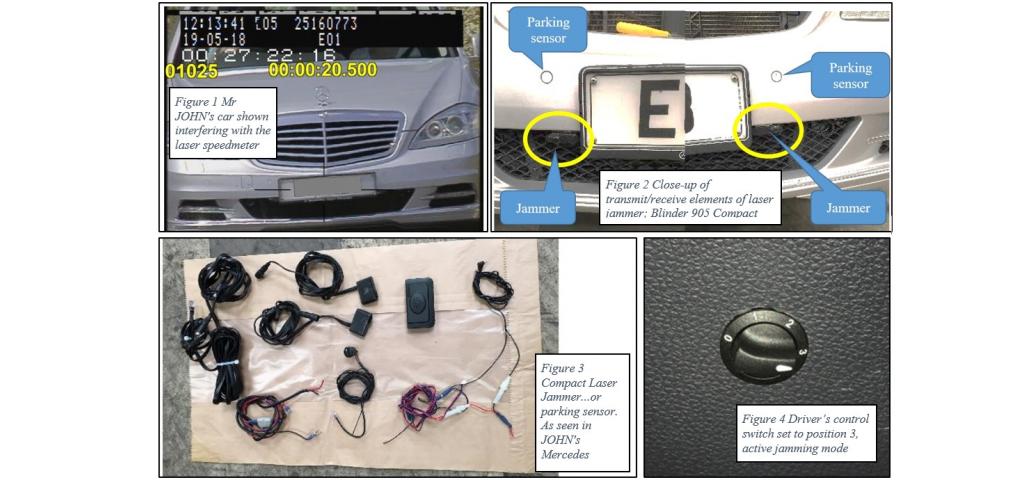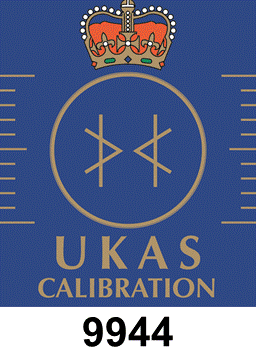Laser jammer driver jailed for
eight months

A man has been given an eight-month prison sentence after being found guilty of perverting justice when he prevented the speed of his car being read by a laser speedmeter. The prison sentence was reduced from 12 months to eight months, the judge then committed Mr John to immediate custody.
On Saturday 19 May, 2018, an operator of an LTI20.20 Ultralyte 1000 coupled to a video camera attempted to measure the speed of a silver Mercedes-BENZ S350 driven by Keith John. The video shows that the operator has attempted to measure the speed of the subject vehicle with the laser speedmeter but no speed could be obtained.
The operator of the device had attended a course that instructed laser speedmeter operators to recognise when the speed gun was being interfered with by countermeasure devices sold to those who wish to defy the use of police speedmeter equipment. Recognising that the error messages shown on the speed gun were not normal in the circumstances, the operator reported the incident for further action to supervisors and enquiry officers at Dyfed Powys police.
Assistance was requested by Dyfed Powys Police from Road Safety Support and the video of the incident was sent for investigation by Steve Callaghan, Road Safety Support's laser jammer expert.
The video image, see figure 1 above, shows 2 black rectangular objects fitted to the front of the vehicle, one on each on the lower sides of the registration plate. This is a typical shape and location for the transmit/receive modules of a laser jammer. The purpose of the jammer is to receive the infra-red light from the speedmeter and to determine how quickly it flashes the laser at the vehicle during the speed measurement.
Once the flash rate is determined, usually within 3 or 4 flashes, the jammer then sends very bright flashes of infra-red light back to the speedmeter that are arranged to confuse it. As a result, the speedmeter will show error indications that are normally seen by operators every day. On the LTI20.20 UL1000 these are seen as E01, E02 and E03. A ProLaser device will show no speed and will give the target not obtained sound. The image from the video in figure 1 shows an EO1 indication, normally shown when no reflections are seen from a target vehicle. The EO1 is caused by the laser speedmeter receiver being interfered with by the laser jammer.
Steve Callaghan examined the video and confirmed that the device seen and the reaction of the laser speedmeter confirmed that there was a laser jammer device fitted to the car and it had prevented the speed reading. The speedmeter could be seen to measure the speed of a car immediately before and immediately after the attempt to measure Mr John’s Mercedes so it was obvious that the speedmeter was working correctly at the time.
PCs Whiles and Jones visited John’s home and asked him what the device was on the front of his car.
On 1 April, 2019, Steve Callaghan inspected the Mercedes S350. The jammer was clearly visible (see Figure 2) at the front of the vehicle in the place it was seen in the enforcement video. Other components of the jammer were found concealed within the car (see Figures 3 & 4). A laser speedmeter was used to test whether the jammer interfered with the laser. At the same time, the warning signals that would be seen and heard by the driver when the laser was used to try to measure John’s speed were recorded by a video camera.
When the Blinder 905 encounters a police laser speedmeter it makes a very loud and continuous warning sound that is equivalent to the loudness of the noise from a petrol lawn mower. The system will also use a synthesised human voice to announce the make and model of the laser speedmeter it has encountered.
The jammer will, at this time, send out pulses to stop a speed reading for a period of eight or more seconds before it stops sending that jamming signal. Inside that eight second period the driver, so warned, will be able to brake and slow the car down to a legal speed before the laser is allowed to show the speed on its display.
With the expert report from Steve Callaghan, the Crown Prosecution Service in South Wales decided that there was sufficient information to make a charge of perverting justice against Mr John. His trial was held at Merthyr Tydfil Crown Court between 18 to 21 May, 2021, with sentencing deferred to 11 June 2021.
In his defence Mr John sought assistance from Michael Prime of Keith Borer Forensic Consultants. Mr Prime examined a report from Steve Callaghan, who had previously reported that Mr John had driven his vehicle at 66 mph in a 60 mph speed limit, then slowing the vehicle to just a little more than 40 mph as it drew nearer to the enforcement camera.
Mr Prime took issue with the ability of Steve Callaghan to determine an accurate speed from the video recording, stating that the possibility of uncertainty of the distance moved by the vehicle was too great to determine an accurate speed. Steve countered this by explaining to Mr Prime, a retired collision investigator, how precision in the determination of motion could be refined in a series of video images.
Steve managed to persuade the court to accept his methodology in preference to what Steve said were no more than guesses in the magnitude of inaccuracy by Mr Prime; guesses which conveniently resulted in Mr Prime calculating a speed close to 60 mph in a 60 mph speed limit for the subject vehicle.
At the trial, John's defence was in 4 main strands:
1. That the laser jammer was a parking sensor and was not bought as a laser jamming system
2. He didn’t drive his vehicle at a speed in excess of 60 mph
3. Because his vehicle was not being driven at excess speed there was no need to have the jammer set to jam, it was set to position one, parking sensor, not position three, the jamming mode
4. Steve Callaghan’s opinions were not accepted
For the prosecution the operator of the device and two police officers as well as Steve Callaghan gave evidence.
Mr John and one other witness for John gave evidence for the defence. Mr John said that the rotary switch on the jammer had been inadvertently “knocked to position 3 from 1”.
At the end of the trial the jury were apparently not convinced by Mr John’s defence, returning to give a guilty verdict only 11 minutes after retiring. The judge adjourned the hearing for sentencing on 23 July, 2021.
The judge gave John a 12-month prison sentence but reduced that to eight months committing Mr John to custody.
Steve Callaghan said that despite a determined and tricky defence made by Mr John, the jury had seen that the use of the device was more likely to be unlawful and deliberate rather than accidentally being set to the jamming mode as claimed.





